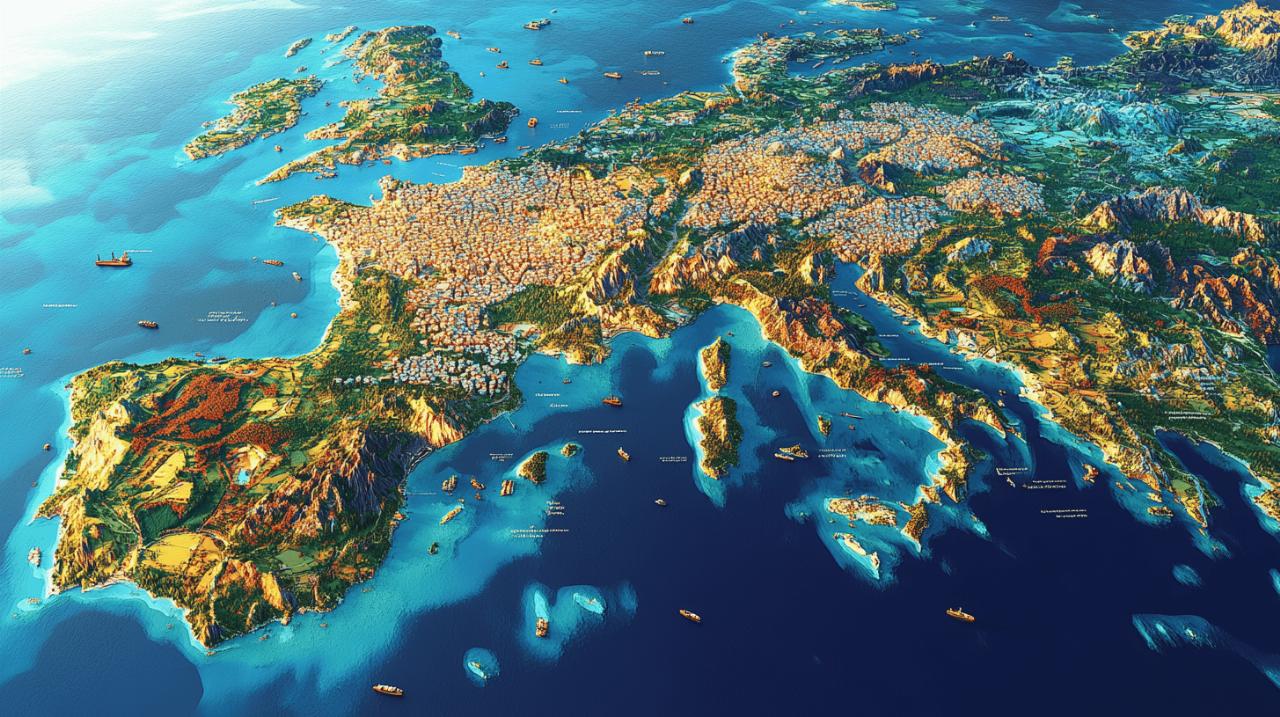Greece stands as a nation deeply shaped by its geographical tapestry and the ebb and flow of its people, with its mainland and island communities forming a complex demographic mosaic. In recent years, the country has found itself navigating significant shifts in population figures, economic pressures, and social transformations that ripple from the bustling streets of Athens to the quiet shores of its Aegean islands. Understanding the population of Greece in 2023 requires more than a mere glance at statistics; it demands an exploration of the forces that mould its communities, from birth rates and migration patterns to the seasonal rhythms of tourism and the persistent pull of urban centres. This comprehensive examination delves into the demographic realities that define contemporary Greece, offering insight into both the challenges and the character of a nation at a crossroads.
Greece's overall population landscape in 2023
Current population figures and demographic distribution
As of 2023, Greece is home to an estimated population of approximately 10.4 million people, a figure that reflects both the inhabitants of the mainland and those scattered across the country's numerous islands. This total represents a subtle yet significant decline from previous years, continuing a trend that has become increasingly evident in recent census data. The 2021 census, conducted by the Hellenic Statistical Authority, recorded a total of 10,482,487 residents, comprising 5,356,510 women and 5,125,977 men. This marked a decrease of 383,805 people compared to the 2011 census, a drop of 3.5 per cent that underscores the demographic pressures facing the nation. The Hellenic Statistical Authority, known as ELSTAT, regularly publishes a quarterly report titled GreeceinFigures, which provides a detailed demographic, social, and economic snapshot of the country. This publication, available in both Greek and English, is updated on the first Wednesday of each quarter and serves as a vital resource for understanding the shifting dynamics of Greece's population. The data compiled by ELSTAT not only captures the raw numbers but also highlights the distribution of residents across different regions, revealing a landscape marked by significant regional disparities. Attica, the region encompassing Athens, remains the most densely populated area, housing 3,814,064 residents or 36.3 per cent of the total population, a concentration that reflects the enduring magnetism of the capital and its surrounding areas.
Mainland versus island population dynamics
The division between mainland and island populations in Greece reveals a fascinating interplay of geography, economy, and lifestyle. While the mainland, particularly areas surrounding Athens and Thessaloniki, contains the bulk of the Greek population, the islands contribute a substantial and culturally vital share. The islands, numbering in the hundreds, vary dramatically in size, population, and economic activity. Some, like Crete, are home to hundreds of thousands of permanent residents, while others support only a handful of families year-round. The population figures for individual islands can fluctuate considerably depending on the season, as the influx of tourists during the warmer months temporarily swells the numbers in popular destinations. This seasonal variation complicates efforts to provide precise population counts for each island, yet it also highlights the economic dependence of many island communities on tourism and the transient nature of their demographic profiles. The mainland, by contrast, experiences less dramatic seasonal shifts but faces its own set of challenges, including urbanisation and the gradual depopulation of rural areas as younger generations migrate towards cities in search of employment and opportunity. This divergence between mainland urban centres and both island and rural communities underscores the broader demographic trends reshaping Greece, where economic necessity and lifestyle choices increasingly drive where people choose to live and work.
The major greek islands and their inhabitants
Crete, Rhodes, and Corfu: Population Centres of the Aegean
Among the Greek islands, Crete stands out as the most populous, with an estimated population exceeding 600,000 residents. As the largest island in Greece, Crete functions as a regional hub, hosting a diverse economy that spans agriculture, tourism, and services, all of which sustain its sizeable population. The island's cities, including Heraklion and Chania, serve as vibrant centres of commerce and culture, attracting both permanent residents and seasonal workers. Rhodes, another major island in the Aegean, is home to approximately 115,000 people. Its strategic location and historical significance have long made it a focal point for trade and tourism, and its population benefits from a steady flow of visitors drawn to its ancient ruins and sun-drenched beaches. Corfu, nestled in the Ionian Sea, boasts a population of around 100,000 residents. Known for its lush landscapes and Venetian architectural heritage, Corfu has cultivated a reputation as a destination for those seeking both natural beauty and cultural richness. These three islands, while differing in character and location, share a common thread of economic vitality and demographic stability relative to their smaller counterparts, yet they too are not immune to the broader trends of ageing populations and the challenges posed by seasonal economic fluctuations.
Smaller islands and seasonal population variations
Beyond the major islands, Greece is dotted with smaller islands such as Lesbos, Kos, and Mykonos, each with populations ranging from a few thousand to tens of thousands of permanent residents. These islands often experience dramatic shifts in population during the tourist season, as holidaymakers flock to their shores seeking sun, sea, and authentic Greek culture. The seasonal influx can double or even triple the effective population of some islands, placing strain on local infrastructure and resources while simultaneously driving the economy. For many of these smaller islands, tourism represents the lifeblood of the community, providing employment and income that sustain residents through the quieter winter months. However, this dependence on seasonal visitors also creates vulnerabilities, particularly in times of economic downturn or global disruptions to travel. The population dynamics of these islands are further complicated by the tendency of younger residents to seek opportunities on the mainland or abroad, leaving behind an ageing demographic that struggles to maintain traditional ways of life. Despite these challenges, the smaller islands remain cherished parts of the Greek identity, each contributing its unique character and history to the broader national narrative.
Economic indicators shaping greece's population trends
Employment patterns and urban migration
 Economic factors play a pivotal role in shaping where Greeks choose to live and work, with employment opportunities acting as a powerful magnet drawing people towards urban centres. Athens and Thessaloniki, as the primary economic hubs of the country, offer a concentration of jobs in sectors ranging from finance and technology to services and retail, creating a gravitational pull that has steadily drained rural areas and smaller islands of their younger populations. This urban migration reflects broader trends seen across much of Europe, where the promise of better wages, career advancement, and modern amenities outweighs the appeal of traditional lifestyles in less developed regions. The economic crisis that gripped Greece in the early 2010s intensified these patterns, as high unemployment rates and austerity measures forced many to relocate in search of stability. While recent years have seen modest economic recovery, the legacy of the crisis lingers, particularly in the form of a brain drain that has seen educated young Greeks emigrate to other European Union countries or further afield. The Greek state has attempted to address the demographic decline primarily through economic interventions, yet these efforts have struggled to reverse the tide of migration or to incentivise family formation and childbearing. A comprehensive demographic policy, one that addresses not only economic conditions but also social and cultural factors, remains a pressing need if Greece is to stabilise its population and ensure the vitality of its communities, both urban and rural.
Economic factors play a pivotal role in shaping where Greeks choose to live and work, with employment opportunities acting as a powerful magnet drawing people towards urban centres. Athens and Thessaloniki, as the primary economic hubs of the country, offer a concentration of jobs in sectors ranging from finance and technology to services and retail, creating a gravitational pull that has steadily drained rural areas and smaller islands of their younger populations. This urban migration reflects broader trends seen across much of Europe, where the promise of better wages, career advancement, and modern amenities outweighs the appeal of traditional lifestyles in less developed regions. The economic crisis that gripped Greece in the early 2010s intensified these patterns, as high unemployment rates and austerity measures forced many to relocate in search of stability. While recent years have seen modest economic recovery, the legacy of the crisis lingers, particularly in the form of a brain drain that has seen educated young Greeks emigrate to other European Union countries or further afield. The Greek state has attempted to address the demographic decline primarily through economic interventions, yet these efforts have struggled to reverse the tide of migration or to incentivise family formation and childbearing. A comprehensive demographic policy, one that addresses not only economic conditions but also social and cultural factors, remains a pressing need if Greece is to stabilise its population and ensure the vitality of its communities, both urban and rural.
Tourism's Impact on Island Demographics and Local Economies
Tourism stands as one of the most significant economic forces shaping the population dynamics of the Greek islands, providing both opportunities and challenges for local communities. The seasonal nature of tourism means that many islands experience a boom during the summer months, when visitors arrive in droves, filling hotels, restaurants, and beaches, and generating income that sustains residents through the quieter off-season. This influx creates temporary employment opportunities, drawing workers from the mainland and even from abroad, and it can give the impression of bustling, thriving communities. However, the reliance on tourism also exposes these islands to economic volatility, as shifts in global travel trends, economic downturns, or health crises can dramatically reduce visitor numbers and devastate local economies. Moreover, the emphasis on tourism can distort local economies, leading to inflated property prices, a shortage of affordable housing for permanent residents, and a decline in traditional industries such as fishing and agriculture. The demographic impact is profound, as young people, unable to find stable year-round employment or afford housing, often leave for the mainland or other countries. This exodus contributes to the ageing of island populations and the gradual erosion of the social fabric that has long defined these communities. Balancing the benefits of tourism with the need for sustainable, diversified economies remains a critical challenge for policymakers and local leaders alike.
Social factors influencing greek population statistics
Birth rates, ageing demographics, and migration patterns
The demographic crisis facing Greece is perhaps most starkly illustrated by its persistently low birth rates and rapidly ageing population. The total fertility rate in Greece stands at just 1.32, far below the replacement level of 2.1 required to maintain a stable population without immigration. In 2023, the country recorded its lowest number of births in 93 years, with only 72,244 babies born, a figure that underscores the severity of the situation. This decline in births is driven by a complex mix of economic insecurity, changing lifestyle choices, and shifting social values, with many young Greeks delaying or forgoing parenthood altogether in favour of careers, personal pursuits, or simply the lack of financial stability necessary to support a family. At the same time, the population is ageing, as longer life expectancies and declining birth rates combine to shift the demographic balance towards older age groups. This trend places increasing pressure on social services, healthcare systems, and pension funds, creating a looming fiscal challenge for the Greek state. Migration patterns further complicate the picture, as Greece has experienced both emigration and immigration in recent decades. Historical factors, including the devastation of World War II, the Greek civil war, and the large-scale emigration of the mid-twentieth century, have left lasting scars on the population structure. Between 1961 and 1977, over one million Greeks emigrated permanently, with another million leaving temporarily, a mass exodus driven by economic hardship and political instability. In recent years, the economic crisis of the 2010s prompted a new wave of emigration, particularly among the young and educated, seeking opportunities in other European countries or beyond. At the same time, Greece has received significant numbers of immigrants and refugees, adding new layers of diversity to its population but also presenting challenges in terms of integration and social cohesion. The net effect of these migration patterns is a population that is shrinking, ageing, and increasingly concentrated in urban areas, with profound implications for the future of the nation.
Quality of Life and Regional Population Shifts
Quality of life considerations are increasingly influencing where Greeks choose to live, with factors such as access to healthcare, education, employment, and cultural amenities all playing a role in shaping regional population shifts. Urban centres, with their superior infrastructure and services, naturally attract those seeking better opportunities and a higher standard of living, while rural areas and smaller islands often struggle to retain residents due to limited access to essential services and economic opportunities. The decline in religiosity and the rise of consumerism and individualism, as noted by observers of social trends, have also contributed to changing priorities, with many Greeks placing greater emphasis on personal fulfilment and material well-being over traditional values such as family and community. These shifts in mentality have implications not only for where people choose to live but also for decisions around marriage and childbearing, further exacerbating the demographic challenges facing the nation. Proposed solutions to address Greece's demographic crisis include a range of measures aimed at both changing social attitudes and providing economic support for families. These include economic incentives for raising children, such as a national salary for stay-at-home mothers, efforts to encourage ethnic Greeks living abroad to return, and broader initiatives to re-imagine the Greek nation in a way that emphasises historical and cultural continuity. Such policies, if implemented with commitment and vision, could help to stabilise the population and ensure that Greece remains a vibrant and cohesive society in the decades to come. Yet, as population projections suggest a decline to 9.6 million by 2050 and potentially as low as 7.45 million by 2100 if current trends persist, the urgency of addressing these issues cannot be overstated. The future of Greece, both on the mainland and across its islands, depends on the willingness of its people and leaders to confront these demographic realities with courage and creativity.


